Abstract
Wireless sensor networks (WSNs) face a fundamental challenge: their sensors run on batteries, making energy efficiency crucial. While researchers have tried to extend network lifespans by improving routing and access control protocols across different layers, this remains a complex issue. One promising solution is opportunistic routing (OR), which uses multiple nodes to relay data. This approach reduces how long senders must wait for a specific next-hop node and helps prevent data loss from collisions. That said, choosing which nodes should act as forwarders can greatly affect how well the network performs. To tackle this problem, we developed a new approach called FCM-OR, a local density-based forwarder selection algorithm for opportunistic routing in WSNs. Our algorithm is particularly effective in networks where sensors are not evenly spread out and are densely packed. It uses fuzzy c-means (FCM) clustering to smartly pick the best forwarders based on how many nodes are nearby. By focusing on the sender’s immediate surroundings, FCM-OR helps solve the problems that arise when different parts of the network have varying densities of nodes. We also created a new way to measure routing effectiveness called “forwarding rank”. To test how well our protocol works, we ran extensive simulations comparing it to existing methods, including opportunistic routing with duty-cycled WSNs and load-balanced opportunistic routing. The results are clear: FCM-OR significantly improves both network performance and energy efficiency, especially in networks where nodes are not uniformly distributed.
1. Introduction
Wireless sensor networks (WSNs) have been developed as a critical component in various monitoring and surveillance applications, including environmental sensing, healthcare, industrial automation, and smart cities. These networks consist of spatially distributed sensor nodes that collect and transmit data wirelessly. However, the energy limits of battery-operated sensor nodes pose a significant challenge, as frequent data transmissions rapidly deplete battery power, reducing network longevity. To address this, extensive research has been conducted on energy-efficient communication techniques to optimize network performance while prolonging sensor node lifetime [1,2].
Among the many energy-saving mechanisms, opportunistic routing (OR) has gained considerable attention for its dynamic and adaptive forwarding strategy. Unlike conventional routing, which relies on predefined paths and fixed next-hop nodes, OR allows data packets to be forwarded via any suitable candidate within the sender’s communication range, ensuring higher reliability and energy efficiency [1]. Moreover, OR is particularly beneficial in duty-cycled WSNs, where nodes alternate between sleep and active states to conserve energy. By selecting early-waking nodes as forwarders, OR can significantly reduce transmission delays and improve network responsiveness [2,3].
Despite its advantages, OR introduces several challenges, particularly in high-density and non-uniformly distributed networks [4]. The fundamental broadcast nature of OR results in multiple receivers capturing the same packet, leading to redundant transmissions, increased collisions, and excessive energy consumption. In dense WSN deployments, this problem becomes more pronounced as more nodes contend for transmission, causing severe network congestion. Additionally, non-uniform node distribution leads to inaccurate routing metric estimations, increasing the likelihood of suboptimal forwarder selection, packet losses, and routing loops. Another key challenge arises when long transmission ranges cause an excessive number of nodes to receive the same packet, further aggravating redundancy and energy inefficiency [5,6].
Several OR-based protocols have been proposed to mitigate these issues. ExOR [1], the pioneering OR protocol, introduced the concept of selecting forwarders based on the expected number of transmissions (ETX) [5], demonstrating improvements in throughput and reliability [1,5]. However, later studies revealed that even minor miscalculations in ETX could lead to routing loops and inefficiencies in multi-hop transmissions [6]. Other protocols, such as ORW [3] and ORR [7], attempted to optimize forwarder selection by limiting the number of active forwarders based on network density. However, these methods rely heavily on global network knowledge, making them less adaptive in dynamic environments.
1.1. Research Motivation
To address these limitations, this study focuses on three key challenges in OR-based WSNs:
- Highly dense networks: excessive node density leads to multiple receivers per packet, causing data redundancy, network congestion, and energy inefficiency (Figure 1) [8].
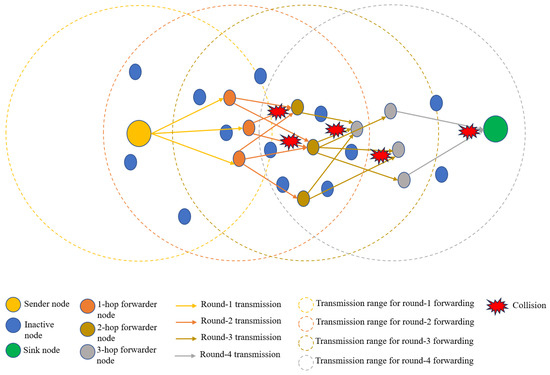 Figure 1. Routing opportunistically in an asynchronous WSN.
Figure 1. Routing opportunistically in an asynchronous WSN. - Non-uniform node distribution: inaccurate density estimations result in poor forwarder selection, increased routing loops, and packet isolation issues [7].
- Long transmission ranges: a higher number of potential forwarders leads to packet duplication, excessive collisions, and reduced network efficiency [9].
1.2. Contributions
To overcome these challenges, we propose FCM-OR, a fuzzy c-means (FCM) clustering-based opportunistic routing protocol:
- Optimization is achieved by prioritizing nodes in the least dense area for the forwarder selection process. This is accomplished by employing FCM for local clustering within the sender’s one-hop neighborhood. The forwarding rank (FR) is then determined using nodes from the least dense cluster, thereby minimizing contention and redundant transmissions. The optimization logic of our protocol is represented by this adaptive and selective forwarder identification.
- This protocol mitigates routing inefficiencies by dynamically adapting to changes in local density. This is achieved by only performing the FCM clustering process when there are more neighbor nodes than a predetermined threshold. As a result, FCM-OR can adapt its behavior according to the local density in real time, guaranteeing efficient routing in both dense and sparse areas.
- We minimize control overheads by performing localized clustering instead of relying on global network knowledge. Moreover, FCM is only performed when the local neighbor count exceeds a threshold, which keeps computational costs on par with existing schemes in sparse regions while enhancing routing efficiency in dense areas.
- This reduces the energy consumption of sensor nodes significantly, extending the network lifetime.
Bezdek [10] first proposed the FCM algorithm. This algorithm has been used in cluster analysis, pattern recognition, and image processing [11,12]. This algorithm is considered a soft partition technique that assigns a degree of belongingness to a cluster to each sensor node. It has been applied to WSNs [11,13,14,15] and can enhance network performance in terms of energy conservation, where data aggregation (on cluster heads) is used to minimize data forwarding (of cluster members) in the entire network. However, the clustering method was used in this study to choose potential forwarders from a less dense area to minimize the multiple receiver problem and control data forwarding between them. Thus, forwarded packets can avoid highly dense areas and redundant transmissions can be reduced.
FCM-OR is the only opportunistic routing protocol that uses soft clustering locally for routing decision-making, as opposed to other protocols that either use fixed routing metrics or depend on global density information. This protocol integrates clustering with FR computation in a density-sensitive and energy-aware way, which is different from previous work. By integrating FCM clustering with opportunistic routing, our protocol significantly reduces redundant transmissions, enhances energy efficiency, and improves overall network performance [10,16].
1.3. Paper Organization
The remainder of this paper is structured as follows: Section 2 provides an overview of related work. Section 3 outlines the preliminaries and assumptions underlying the proposed method. Section 4 details the FCM-OR protocol and its methodology. Section 5 presents simulation results and performance evaluations. Section 6 and Section 7 discuss key findings and future research directions, respectively. Finally, Section 8 concludes the paper with insights and contributions.
2. Related Works
Opportunistic routing (OR) has undergone significant advancements since the introduction of ExOR by Biswas and Morris in 2005 [1]. While ExOR demonstrated improved throughput and reliability over traditional fixed-path routing, its impact on energy consumption remained largely unexplored. This limitation prompted extensive research into energy-efficient OR protocols for wireless sensor networks (WSNs), leading to the development of several OR-based solutions [17,18,19,20,21,22]. Early protocols were designed for always-on networks, but later adaptations incorporated duty-cycled medium access control (MAC) mechanisms to reduce power consumption [3,7,8,9,23,24,25,26].
To optimize forwarder selection, researchers introduced various routing metrics, including hop count [27,28,29,30,31], geographical distance [32,33,34,35,36], expected transmission count (ETX) [1,18,20,37,38], expected transmission time (ETT) [39,40,41] and coding gain [42]. For duty-cycled WSNs, a new metric called expected duty cycle (EDC) [3] was proposed to measure the number of wake-up cycles required for successful packet delivery. Further refinements led to expected any-path transmission count (EAX) [17,43,44,45] and expected any-path transmission time (EATT) [46], both designed to enhance OR efficiency under duty-cycled conditions. Additional metrics, such as dynamic forwarding delay [47], incorporated parameters like link quality, node mobility, and directionality to improve routing performance.
Many OR protocols aimed to maximize energy efficiency and prolong network lifetime by integrating residual energy awareness into routing metrics [3,7,8,9,19,23,24,48,49,50]. Notable approaches include OAPF [17], which employs EAX-based prioritization, and MORE [18], SOAR [20], and OMNC [22], which extend ExOR’s ETX-based selection strategy. Conversely, OPRAH [28] focused on link quality, contradicting OR principles by restricting forwarder choices to high-quality links. EFFORT [21] introduced an end-to-end cost metric that balances multiple factors to optimize routing decisions.
A significant advancement in OR was introduced with ORW [3], which utilized EDC for forwarder selection while implementing duty cycling to reduce energy consumption. However, ORW suffers from several limitations: (i) high computational overhead due to recursive EDC calculations; (ii) poor load balancing, as the lowest-EDC node is frequently selected, leading to rapid energy depletion; (iii) the lack of a forwarder limit, resulting in redundant transmissions and routing loops. Building on ORW, ORD [8] and ORR [7] introduced modifications to improve efficiency. ORD reduces transmissions by aggregating multiple packets, but this increases latency. ORR introduced the forwarder score, incorporating residual energy into forwarder selection, but heavily favoring high-energy nodes may lead to congestion and uneven energy depletion.
Further advancements include MOR [51], which integrates multi-channel transmission into ORW, allowing the first node that wakes on the correct channel to forward packets. However, frequent channel switching incurs excessive energy costs. LEOR [24] mitigates this by restricting forwarder selection zones and prioritizing nodes based on distance, residual energy, and connectivity, although at the expense of increased overhead due to RTS/CTS/ACK mechanisms. MORR [9] extends ORR by addressing channel interference and forwarder load balancing, but its transmitter regulation mechanism lacks adaptability.
Geometric-based OR techniques, such as LORA [23], introduced candidate zones (CZs) to define spatially constrained forwarder selection areas based on factors like directionality, transmission distance, and residual energy.
However, high computational costs and inconsistencies in randomly deployed networks limit its practicality. LDORRO [25] refines LORA by dynamically segmenting the candidate area and implementing predefined routing rules, yet its static duty cycle configuration lacks adaptability to network topology changes. TORAS [26] improves reliability by incorporating a trust model for forwarder selection but requires extensive global network information, resulting in high computational overhead.
Recently, Wang et al. [52] proposed a dynamic OR protocol leveraging an analytic hierarchy process (AHP) and fuzzy inference system (FIS) to adjust duty cycles based on residual energy, traffic conditions, and link quality. While this approach enhances network longevity, its high computational complexity limits feasibility in resource-constrained WSN environments. Furthermore, scalability issues remain unaddressed, raising concerns about its applicability in large-scale deployments.
Most existing OR protocols adopt either centralized or distributed approaches to compute routing metrics, both of which incur high overhead costs. To address these limitations, our proposed protocol introduces a lightweight, local computation-based method that eliminates the need for explicit neighbor probing or additional control packet exchanges. By embedding routing metric recalculations within transmitted packets, our approach enables dynamic adaptation without global state awareness. Moreover, by employing soft clustering techniques, forwarder selection is optimized to prioritize low-density areas, thereby reducing redundant transmissions, minimizing collisions, and improving energy efficiency in opportunistic duty-cycled WSNs.
Although fuzzy clustering has been used in WSNs before for topology control and data aggregation, our work stands out because it only uses local FCM clustering for dynamic forwarder selection. On-demand reactivity without centralized control is made possible by this clustering, which is localized to one-hop neighborhoods rather than global ones. Additionally, unlike protocols like LORA [23] or MORR [9], we do not rely on centralized re-clustering or heavy computation.
Comparing FCM-OR to more varied classes of existing protocols, like LORA [23], LDORRO [25], and LEOR [24], that employ geometric or trust-based forwarder selection strategies would help to shed light on the novelty of our method. Table 1 presents a concise summary of previous related works within the scope of our protocol research area and provides a brief comparison with the proposed protocol. For now, in this study, we have implemented and compared our proposed protocol with two well-known protocols in the opportunistic routing field, ORW [3] and ORR [7]. ORW and ORR have been used by other protocols such as ORD [8], MOR [51], and MORR [9], and our work will be empirically compared to those models in future iterations.

Table 1.
Summary of previous related works in the area of opportunistic routing in WSNs.
3. Preliminaries
In this section, the assumptions related to the network preferred for the proposed protocol are explained. The MAC scheme used as the baseline MAC mechanism to reduce energy consumption in the proposed OR protocol, FCM-OR, is described in detail. Finally, the FCM clustering algorithm used in the protocol to measure the local density is presented.
3.1. System Model
In this study, we present an opportunistic routing (OR) protocol that integrates a clustering mechanism within the routing layer. This clustering approach enables the protocol to assess local node density, a key factor in accurately computing the routing metric for optimal forwarder selection in wireless sensor networks (WSNs). The clustering scheme enhances the efficiency of forwarder selection by accounting for local network conditions, ensuring that data forwarding decisions are both dynamic and context-aware. To establish the system model for the proposed protocol, we operate under the following key network assumptions:
- The sensor nodes are battery-operated, and each node has a unique ID.
- nodes are randomly deployed in an m × n meter square-shaped sensor field. Thus, the network has an uneven density of nodes (Figure 2) [23].
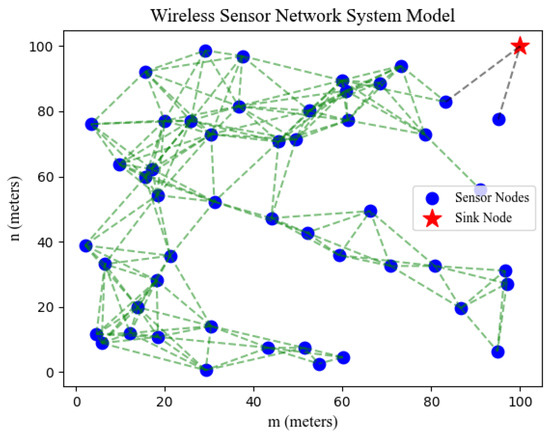 Figure 2. System model.
Figure 2. System model. - All nodes have information about the total number of nodes in the network.
- We assume that the sink node has enough energy supply. Thus, the sink node is active throughout the time, resulting in duty cycle 1.
- It is assumed that all nodes have access to their own positional information at the time of deployment.
- The sensor nodes are homogenous and have the same transmission range, l. Therefore, nodes with a longer distance from the sink than the transmission range need to transmit through multiple nodes, which leads to a multi-hop network.
- All nodes follow their schedule of duty cycles; however, they share the same sleep interval. There is no scheme of synchronization among them.
- When the nodes are active, they monitor the environment and generate data for any event-triggered activity.
- All nodes are static and have the same initial energy, .
- Following the cluster-formation phase, each node can be a member of only one cluster, and clustering is based on the positions of the forwarder nodes relative to the position of the sender node.
3.2. BoX-MACProtocol in MAC Layer
The proposed protocol incorporates an existing medium access control (MAC) protocol at the MAC layer inspired by the BoX-MAC scheme [53]. BoX-MAC offers two operational modes: one that utilizes acknowledgments (ACKs) and another that does not. In this study, we adopt the ACK-enabled mechanism, where data are transmitted directly alongside the beacon. Each node operates on an independent duty cycle without requiring synchronization among nodes. However, the entire network follows a common sleep interval. BoX-MAC is a sender-initiated protocol, meaning that transmissions are triggered by the sender node. Upon waking, a node passively listens to the channel to determine if it is occupied. If no data are queued for transmission, the node remains silently active, continuing to monitor the channel until the active period expires.
We selected BoX-MAC due to its widespread support in the Castalia simulator and its ability to work with asynchronous duty-cycled WSNs. In line with the FCM-OR design, BoX-MAC minimizes idle listening and does not require global synchronization. By decreasing forwarder redundancy at the routing layer, we mitigate its disadvantages, which include increased ACK traffic and limited adaptability under high contention.
On the other hand, if a node has a packet to transmit, it first verifies the channel’s availability. Once the channel is clear, the node immediately sends the packet and waits for an acknowledgment (ACK) from the receiver. The node continues transmitting the packet periodically in this sequence until an ACK is received. Upon receiving the ACK, the sender terminates further transmissions from the MAC layer. If no ACK is received within a predefined timeout period, the transmission process is halted. An example of the data transmission process implemented in the BoX-MAC protocol is illustrated in Figure 3.

Figure 3.
Data transmission procedure in the MAC layer (BoX-MAC) in the proposed FCM-OR protocol.
3.3. FCM Clustering Scheme in Routing Layer
Fuzzy c-means (FCM) clustering is utilized in the forwarder selection process to identify low-density regions for optimal packet forwarding. As an unsupervised clustering technique based on fuzzy set theory, FCM allows nodes to belong to multiple clusters with varying membership degrees. Unlike traditional hard clustering, this method assigns a participation cost to each node, proportional to its distance from the cluster centroid, enabling dynamic adaptation to network density. The number of clusters is determined locally within the sender node’s transmission range, ensuring flexibility in dynamic network conditions [11,54]. Previous research has explored FCM at the global network level for WSN optimization [11,54]. However, this study is the first to integrate FCM locally within an OR protocol for forwarder selection, significantly reducing control overhead by eliminating the need for network-wide clustering updates. Instead, clustering calculations are performed locally, enhancing efficiency while minimizing communication overhead. Given these advantages, FCM is adopted as the clustering mechanism in the proposed OR protocol. However, the protocol is kept lightweight by localizing all FCM and FR computations within the one-hop neighborhood and avoiding them completely if the neighbor count is small. The following part of this section outlines the detailed procedure for FCM calculation.
When the neighborhood density or the number of potential forwarders surrounding a sensor node exceeds a defined threshold, the sender node initiates the clustering algorithm using the fuzzy c-means (FCM) method. As an unsupervised clustering technique, FCM does not require predefined convergence values for cluster formation. Instead, the process begins with the initialization of a membership matrix. The membership matrix (U) is a two-dimensional array that assigns each node a degree of belonging to each cluster. The sum of membership values for any given node across all clusters equals 1. Once the number of clusters is determined, the membership matrix is initialized, and subsequent calculations are performed iteratively until the optimal clusters are identified. To initialize the membership matrix, the sender node first determines the optimal number of clusters based on the number of neighboring nodes (primary forwarder set) within its transmission range. The following formula is used for calculating the optimal number of clusters:
Here, n represents the number of nodes in the primary forwarder set, which also represents all known neighbor nodes under the sender node’s transmission range. Additionally, and represent the energy required for transmitting a single bit of data to obtain the minimum bit error rate; they are dependent on the transmission distance in a free-space model or a multi-path fading model, respectively [55]. denotes the transmission range of a sensor node, which is the same for all the nodes in the network. Additionally, represents the average Euclidean distance between the calculating sender node and the forwarder nodes.
Initially, cluster centroids are randomly assigned based on the number of clusters and the communication range of the nodes. These centroids serve as the starting points for membership calculations. After the centroids are initialized, each node is assigned a membership value representing the degree to which it belongs to a specific cluster. The FCM clustering algorithm then follows these iterative steps:
Step 1: For each node in the primary forwarder set, a membership matrix U is initialized where the value will be the probability of node i being in a specific cluster j; . Prior to that, the number of clusters is calculated using (1).
Step 2: Once the membership matrix is initialized, the centroid position for each cluster, , will be recalculated using the following equation [54]:
Step 3: The membership matrix is updated based on the change in centroid positions using the following equation [54]:
Step 4: Steps 2 and 3 are repeated until the algorithm converges (the difference between the newly calculated fitness value and the previously calculated fitness value is so small that it can be ignored). The following equation is used to evaluate the fitness value in any iteration [54]:
Step 5: Once the algorithm converges, the nodes are classified depending on their membership value. The node that has the highest membership value for a specified cluster is assigned to that cluster. Finally, nodes from the smallest cluster are selected for the routing metric calculation.
4. Proposed Methods
The proposed opportunistic routing (OR) protocol enhances forwarder selection by dynamically controlling the number of forwarders. During packet transmission at the MAC layer, each node embeds routing metadata such as the position, forwarder rank (FR), and routing metrics. This information is stored for future FCM and FR calculations. When a node receives a transmission request, it executes the FCM clustering algorithm if the number of potential forwarders exceeds a predefined threshold, segmenting forwarders into clusters. Nodes from the smallest cluster are selected for FR computation, while those farther from the sink are excluded to prevent unnecessary forwarding. The FR value is attached to outgoing packets, enabling receiving nodes to assess their eligibility as forwarders. Nodes with an FR value lower than or equal to the sender forward the packet after providing an ACK, whereas higher FR nodes discard it, reducing routing inefficiencies.
To mitigate redundant transmissions, while a node is waiting to forward a packet or ACK, if it overhears any retransmission of the same data packet that it saved or overhears ACK for the same packet that has a smaller FR value than itself, the packet is instantly discarded by the node. The clustering algorithm is triggered only when node density surpasses a threshold, minimizing computational overhead. Additionally, each node maintains a list of broadcasted packet IDs, ensuring efficient duplicate suppression and optimizing network performance. The overall operation of the proposed OR protocol is structured into two distinct phases:
- The setup phase;
- The data-Forwarding phase.
Each of these phases has its step-by-step procedures, which are explained in Figure 4.
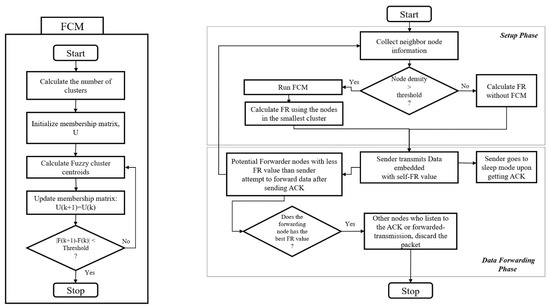
Figure 4.
Workflow diagram of our proposed protocol, FCM-OR.
4.1. Setup Phase
4.1.1. Neighborhood Discovery
At network initialization, each node undergoes a setup phase to discover neighborhood and routing parameters. Initially, nodes wake asynchronously and listen for beacon signals [53] from neighboring nodes. Because of beacon exchanges, this phase adds a small control overhead. Routing metrics can be initialized without further probing since each node sends and receives one setup packet and packets from its neighbors. Control overhead stays within reasonable bounds because the one-time neighborhood discovery usually finishes in one duty-cycle period (610 ms). The total setup-phase time of the network depends on the hop distance from any corner of the sensor field to the sink node. For our smooth simulation purpose, we have used a starting packet delay for 10 s. Which means the first packet of the network will be generated after 10 s, so that the setup control packet does not collide with the actual data packets.
The beaconing mechanism employed in this protocol aligns with the BoX-MAC protocol [53], as BoX-MAC serves as the underlying MAC layer protocol. The sink node exclusively initiates the setup phase by broadcasting a setup control packet, which contains essential node information. Upon receiving the initial setup packet, neighboring nodes update their routing metrics and rebroadcast the information to propagate network-wide topology awareness. When a node in the vicinity of the sink receives this setup packet, it computes its distance to the sink using the Euclidean distance formula, leveraging the location data embedded in the setup packet along with its predefined positional coordinates, which are assumed to be known at deployment. The receiving node then appends its own position information to the setup packet and forwards it to other nodes farther from the sink. This process continues recursively, ensuring that all nodes in the network acquire one-hop neighbor information, including their respective positions. Following the completion of the first step of the setup phase, each node independently calculates and updates its forwarding rank (FR) based on the collected topological and positional data. Each time a data packet is transmitted, it carries an updated routing metric, enabling neighboring nodes to dynamically refine their routing tables. Furthermore, whenever a node detects a beacon or overhears a data packet, it immediately updates its neighbor information table. Over a predefined interval, nodes accumulate sufficient neighborhood data, facilitating optimized routing decisions based on local topology variations.
4.1.2. Decision Making
Depending on the neighborhood density, the sender node determines whether to run the clustering algorithm or calculate FR without using the FCM clustering method. Once a decision is made, the sender node executes the process and calculates FR. This FR value is then used as a threshold value to select the forwarder nodes.
4.1.3. Routing Metric Calculation
In the proposed protocol, we present a novel routing metric, FR. The FR value was calculated using the FR value of neighboring nodes and the local density around the node’s transmission range. Initially, FCM clustering was used to divide the node’s transmission range area into subareas depending on the neighborhood density. Subsequently, nodes from the smallest cluster were used in the FR calculation. As indicated in [3,7], the nodes closest to the sink have a lower routing metric value, implying that they have better forwarding potential compared with other nodes with a higher value. This routing metric value also indicates the sender’s waiting time in response to the duty cycle and link quality. Additionally, assigning a higher priority to nodes positioned in less-dense areas is conducive to achieving OR characteristics. Based on the aforementioned reasons, we propose using only nodes in less dense areas for the routing metric calculation, which will drive the routing path through a comparatively less dense area when the network has non-uniformly distributed sensor nodes. The routing metric FR was calculated as follows:
where denotes the FR value for node i, and represents the number of nodes in the smallest cluster (after applying the FCM clustering algorithm) in the neighborhood of node i. in (5) indicates the link quality between node i and neighboring node j, which is directly collected from the radio layer. in (6) corresponds to the residual energy parameter of node i [7]. These equations were derived from ORW [3] and ORR [7]. According to the calculation, the smaller the cluster, the smaller the FR value. The pseudocode for the routing metric calculation procedure is shown in Algorithm 1.
| Algorithm 1 Routing metric calculation algorithm |
|
Link quality () is used as a weighting factor in Equation (5), providing more stable links a higher preference. Relative to energy-rich nodes, residual energy () modifies the FR in Equation (6). FCM-OR can function flexibly in settings with various constraints because of these two formulas. The simulation configuration determines which equation is used, and nodes use locally available metrics to calculate FR values, so no manual adjustment of these weights is required during runtime.
The forwarder rank (FR) is computed using two runtime-updated weighting parameters: link quality () and residual energy (). In Equation (5), link quality is used to prioritize nodes with more stable connections to the sender, as this value is collected in real time from the radio layer. In Equation (6), residual energy is used to favor nodes with higher remaining energy, calculated as the ratio of current to initial energy, and continuously updated as nodes overhear packets in their neighborhood. These formulas allow FCM-OR to dynamically adapt to changing network conditions without manual tuning. The choice between the equations depends on the simulation context, and all required metrics are collected locally during runtime.
4.2. Data-Forwarding Phase
4.2.1. Decision Making
The FR is added to the packet header once calculated. The sender node then broadcasts the data packet while piggybacking FR to inform the other nodes of the transmission. Once a packet is received, the receiver nodes verify the FR value attached to it. Suppose the FR of the receiver node is less than that of the sender node. In that case, it saves the packet, provides transmission progress (ACK), and waits before making a forwarding decision or broadcasting the packet. While the node waits, it silently listens to the channel in the case in which it overhears the retransmission of the same data packet from another forwarder in its neighborhood. In this scenario, the node discards the packet. In the absence of retransmission during the waiting time, the node assumes that the packet has not been successfully received by other forwarders and forwards the packet. Suppose the FR of the receiver node is larger than that of the sender node. In that case, the packet is ignored.
4.2.2. Data Forwarding
Once the packet is received, the selected forwarder determines whether it is a potential forwarder node using the attached FR value. Hence, after making the forwarding decision, the forwarder node replaces the FR value with its own FR value and other necessary information regarding the packet header before forwarding the packet.
4.2.3. Coordination Mechanism
The coordination mechanism of FCM-OR is similar to that of the ORW protocol, with some minimal changes. When the sender transmits a packet, it waits for a while to receive an ACK. Suppose it does not receive an ACK after a specific waiting time. In that case, it retransmits the packet to ensure that at least one forwarder receives the packet and forwards it. Meanwhile, suppose one forwarder node obtains the same packet a second time. In that case, it sends an ACK with a 50% probability. After receiving at least one ACK, the sender finally discards the packet and returns to its duty cycle scheduling. In our protocol, we allowed the sender to retransmit a packet once to save energy. Meanwhile, the awaiting forwarder node will discard the packet provided the ACK of another forwarder node is overheard while a potential forwarder is waiting for the forwarding decision, and it has a smaller FR value compared with that of the current node.
Because there are fewer active nodes when routing through low-density areas, especially when duty-cycled MAC is in effect, sender waiting time may increase even though redundant transmissions are decreased. This creates a trade-off between responsiveness in real time and energy efficiency. This delay increase, which is further discussed as a future optimization target in Section 7 and this issue is observed in Section 5.2.11.
5. Performance Evaluation
This section presents a precise and concise analysis of the experimental results, their interpretation, and the conclusions drawn from them. Subheadings are used to organize the results by specific aspects or categories of the experiments. The analysis focuses on identifying key patterns, trends, and insights revealed by the data. Furthermore, the conclusions highlight the practical implications of the findings, as well as their relevance to the objectives of the study.
5.1. Simulation Setup
To evaluate the performance of the proposed methods, we utilized Castalia, an OMNeT++-based simulator written in C++. Castalia is well-suited for WSN simulations, as it incorporates real-world environmental parameters, including carrier sensing, collision handling, individual MAC modules, routing modules, and radio modules. For our simulations, we configured the CC2420 radio module, a built-in parameter setup available in Castalia, to ensure accurate wireless communication modeling.
Since the experiments were conducted in a simulation environment rather than on a real-time testbed, we employed the event-triggered traffic application system named “ThroughputTest”, available in Castalia. In this setup, a randomly selected node generates data packets at specified intervals following a given packet rate. All sensor nodes in the network communicated using the BoX-MAC protocol with duty cycles to conserve energy. Because of its native support in the Castalia simulator and compatibility with asynchronous low-duty-cycle WSNs, BoX-MAC was chosen. It is perfect for comparing lightweight routing protocols like FCM-OR because of its low control overhead and energy-efficient wake-up policy. However, our routing layer improvements recognize and lessen its limited scalability and dependence on ACKs. Our proposed method, FCM-OR, was implemented on this MAC protocol alongside two widely used OR protocols, ORW and ORR, to compare their performance, primarily in terms of energy consumption.
Initially, we deployed 100 to 1000 sensor nodes non-uniformly in a 500 m × 500 m area and placed a sink node at the top-right corner of the sensor field. Except for the sink node, all nodes used a duty cycle ranging from 0.2 to 0.9, and each time frame was fixed at 610 ms. Hence, every 610 ms, the radio of a node changed its state at least once. Each node had a transmission range of 50 m and a carrier sensing range of 100 m. This estimated the minimum hop distance from any corner of the field by approximately 10, and in the worst case, the hop distance could be increased by up to 15. To ensure uneven randomness of the node deployment, we first assumed the sensor field to be a grid and then placed the nodes using a random distribution on discontinuous grid boxes. We increased the distribution number of random deployments on the grid boxes to increase the degree of uneven density of the nodes.
At the start of the simulation, the nodes began their individual duty cycles and waited for a beacon signal [3,53] from their one-hop distance-apart neighbor (nearer to the sink). The sink initiated this process. With this beacon signal, the nodes sent their FR values and information about themselves, which were required to calculate the FR. Unlike ORW and ORR, in the proposed protocol, the received radio signal strength for a node was used as the link quality value for that node. Accordingly, we could save energy that would be spent on the probing method for link quality estimation of a node [3]. We optimized the routing metric equations of ORW and ORR by adding FCM logic for the forwarder node selection (see Equations (5) and (6)).
5.2. Simulation Results
5.2.1. Changes in Network Density vs. Energy Consumption
In the first simulation, we varied the number of nodes from 100 to 1000 and fixed the size of the sensor field. As the sensor field size remained unchanged, increasing the number of nodes was analogous to increasing the network density. We deployed nodes using a non-uniform distribution system. Hence, node density was not the same in different areas of the network. Here, we used a duty cycle of 0.5, meaning the nodes would maintain their radios active for half of the timeframe and sleep for the remaining half. The energy levels shown in the graphs were obtained based on the node energy consumption for the specific runtime of the simulation. Owing to a large number of nodes, we ran each simulation for approximately 10 to 30 rounds at a time and obtained their average. The average energy consumption per node was determined by varying the number of nodes using four OR protocols for comparison with low and high-traffic events. As shown in Figure 5a and Figure 5b, low traffic represents one packet/10 s, and high traffic represents five packets/10 s. Based on these figures, the ORW and ORR protocols showed a considerable increase in energy consumption as the non-uniform node density increased. This is because an increase in the density resulted in an increased number of redundant transmissions.
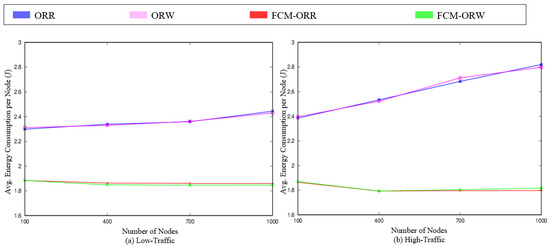
Figure 5.
Comparison of the average energy consumption per node with varying non-uniform densities under different traffic loads.
The proposed protocol, which used the FCM clustering mechanism, outperformed existing protocols. As the network density increased, the energy consumption remained stable and did not exhibit any noticeable changes. This is because as the non-uniform density increased, the protocol used the FCM clustering method to drive the packet toward a lower-density area such that fewer nodes could listen to the packet and retransmit it. Accordingly, the average energy consumption decreased, and the load could be balanced at different densities. In low-traffic and high-traffic environments, FCM-OR could reduce the average energy consumption per node by approximately 12% and 26% compared with the ORW and ORR protocols, respectively.
Moreover, according to our logic, to avoid collisions, the node will back-off and sleep whenever it senses that the channel is busy before transmitting any new packet. Hence, in the case of high traffic, most nodes detect a busy channel and sleep for random back-off before waking up and performing carrier sensing again. This back-off time increases exponentially with the repeated detection of a busy channel. Therefore, during high traffic, the energy consumption is comparatively lower than that of other protocols.
The effects of the duty cycle under the same simulation setup, where the average energy consumption per node was calculated for a single-packet transmission to observe the fundamental performance of each protocol are shown in Figure 6a and Figure 6b. The performance of the protocols when the duty cycle was 0.6 and 0.8 are shown in Figure 6a and Figure 6b, respectively. As shown in the figures, the proposed protocol outperformed the existing protocols, even at a higher duty cycle.
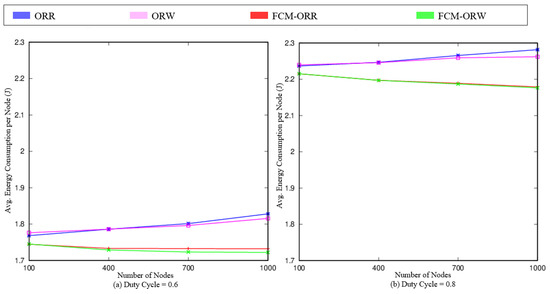
Figure 6.
Comparison of the average energy consumption per node with varying non-uniform densities and duty cycles (for a single packet transmission).
5.2.2. Changes in Network Density vs. Number of Forwarders
The basic performance of the protocols with varying network densities and duty cycles for a single-packet transmission from the source to the sink is shown in Figure 7. The average number of forwarders per hop with increasing node density is shown in the two graphs in Figure 7. As the number of nodes increased, the number of nodes forwarding the packet also increased; however, the increase in the FCM-OR protocol was slower than those in the existing ORW and ORR protocols. The forward count was also lower for the FCM-OR protocol. Although the wake-up period increased, the proposed protocol outperformed the existing protocols.
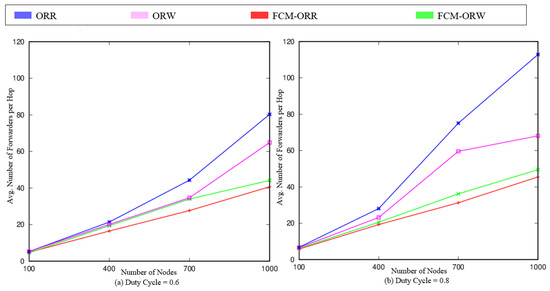
Figure 7.
Comparison of the average number of forwarders per hop with varying non-uniform densities and duty cycles.
5.2.3. Changes in Network Density vs. Network Lifetime
The performance in terms of network lifetime with the same simulation setup as in Figure 5 is shown in Figure 8. The initial battery power used was the same as that of the AA battery, and the network lifetime was calculated in days. The lifetime value represents the lifetime of the first dead node in the network. A duty cycle of 0.5 was used. In addition, packet rates of 0.1 and 0.5 were considered (Figure 8a and Figure 8b, respectively). As shown in the figure, the network lifetime decreased with an increase in density. This is because a highly dense network produces more redundant packets and drains energy more quickly. However, the proposed protocol exhibited relatively better performance, and its network lifetime decreased slowly compared to the others. In high-density FCM-OR, the lifetime was improved by 24% and 27% under low-traffic and high-traffic conditions, respectively.
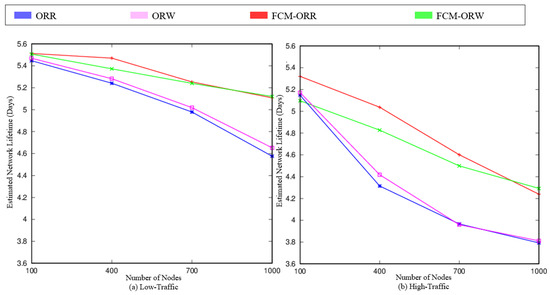
Figure 8.
Comparison of the network lifetime with varying non-uniform densities under different traffic loads.
A comparison of the network lifetime with varying node densities and duty cycles for single packet transmission from source to sink is shown in Figure 9. As indicated in Figure 9a and Figure 9b, the proposed FCM-OR protocol exhibited a longer network lifetime than the ORW and ORR protocols for different duty cycles (0.6 and 0.8). Moreover, as the duty cycle increased, the node lifetime decreased slowly in our protocol compared with other protocols. FCM-OR could improve the lifetime of high-density networks by 5%.
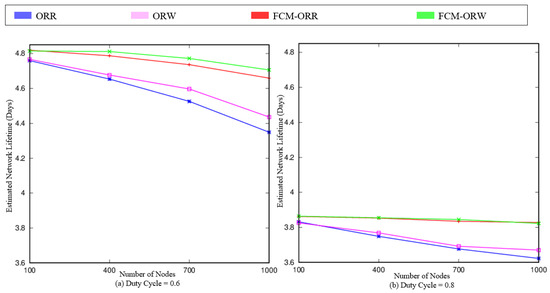
Figure 9.
Comparison of the network lifetime with varying non-uniform densities and duty cycles (for a single-packet transmission).
5.2.4. Changes in Duty Cycle vs. Packet Collision
As the duty cycle or active time of a node’s radio increased, the probability of multiple nodes waking up simultaneously also increased. This phenomenon can increase the number of packet collisions. These collisions could occur between data packets, data packets and ACK packets, or ACK packets. A comparison of the packet collision performances of the protocols is shown in Figure 10. Based on the figures, the number of collided packets also increased with the duty cycle. With increasing duty cycles, the proposed FCM-OR protocol exhibited fewer collisions compared with the existing protocols (ORW and ORR). The simulation was executed at a high node density.
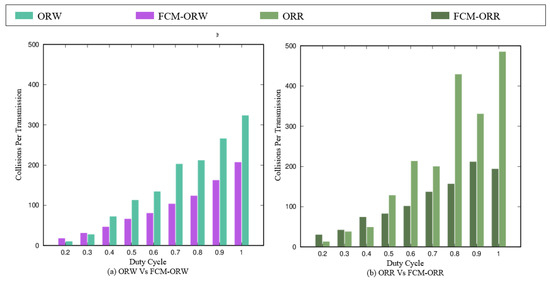
Figure 10.
Comparison of the number of collisions per transmission with varying duty cycles in highly dense sensor fields (number of nodes = 900).
5.2.5. Changes in Duty Cycle vs. Energy Consumption
The basic performance of the protocols in terms of the energy consumption per node under different node densities with varying active radio periods is shown in Figure 11. The simulation was executed with a single-packet transmission from source to sink. As shown in the figures, the energy consumption increased for all protocols when the duty cycle per node increased. However, our protocol consumed less energy compared with existing protocols. As the duty cycle increased, the difference in performance increased proportionally.
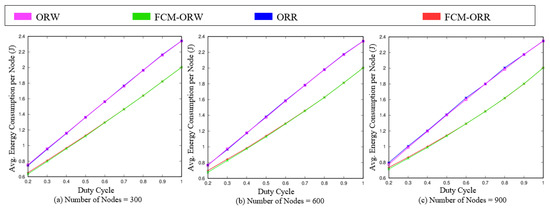
Figure 11.
Comparison of the average energy consumption per node with varying duty cycles and non-uniform densities.
The simulation setup in Figure 11 slightly differs from the simulation setup in Figure 6. In Figure 6, the packet rate was 0.1, meaning a source node initiates a packet transmission after a 10 s interval. However, in Figure 11, the setup shows the basic performance. Hence, only a single packet was processed during the entire simulation. Thus, only one packet was transmitted from the source node. Consequently, even for the same duty cycle and with the same number of nodes, the energy consumption shown in Figure 6 differs from that in Figure 11.
Moreover, the existing implemented protocols and our proposed protocols use the BoX-MAC protocol on the MAC layer. According to the MAC protocol mechanism, after the completion of any type of operation (such as data packet transmission and ACK sending), the nodes return to their previous duty-cycle schedule because, before performing the operations, the nodes cancel all their duty-cycle scheduled timers. Because the scheduled duty-cycle timer has a constant active time duration, the energy consumption graph shows a comparatively smoother linear growth with increasing active time duration (Figure 11). Owing to the MAC mechanism in our Castalia implementation, the duty cycle graph, which should be slightly curved, shows a smoother linear increase.
5.2.6. Changes in Duty Cycle vs. Number of Forwarders
The number of forwarders per packet transmission with increasing duty cycles at different node densities is shown in Figure 12. As the duty cycle increased, the number of forwarders also increased. Accordingly, the probability of multiple forwarder nodes simultaneously waking up also increased. As expected, the number of forwarders increased with an increase in density. At a lower duty cycle, the ORW and ORR protocols performed better. However, as the duty cycle increased, FCM-OR outperformed the existing protocols, and the difference between the performances of the protocols became evident.
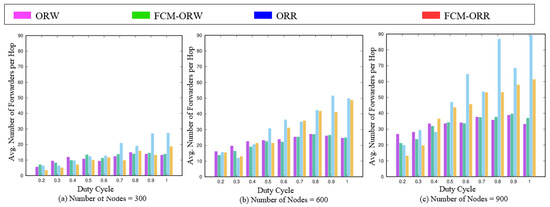
Figure 12.
Comparison of the average number of forwarders per hop with varying duty cycles and non-uniform densities.
5.2.7. Traffic Load vs. Energy Consumption
The average energy consumption per node for various packet rates and traffic loads is shown in Figure 13. Packet rates of 0.1 to 0.5 imply that one to five packets were sent every 10 s during each simulation. The performances of the protocols for 100 to 900 nodes are shown in Figure 13a–d. In each setup, the FCM-OR outperformed the ORW and ORR protocols. The energy consumption per node increased for ORW and ORR with increasing packet rate, traffic load, and network density. In contrast, FCM-OR consumed less energy and the energy load was balanced with varying traffic loads and densities.
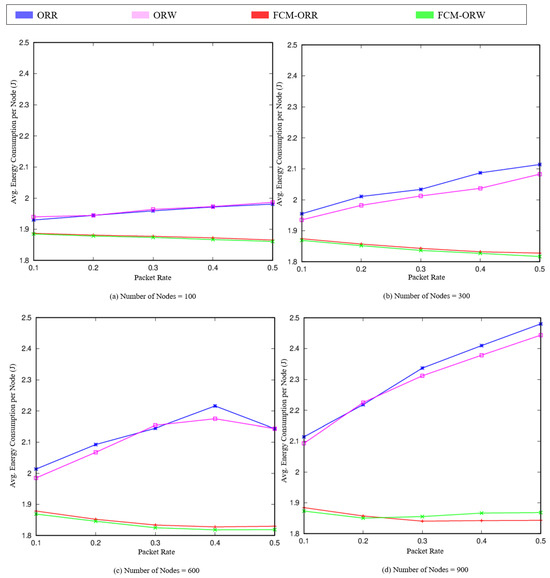
Figure 13.
Comparison of average energy consumption per node with varying packet rates and non-uniform densities.
5.2.8. Traffic Load vs. Network Lifetime
A comparison of the network lifetimes of the protocols with varying packet rates and traffic loads is shown in Figure 14. The network lifetime performances for 100, 300, 600, and 900 nodes are shown in Figure 14a, Figure 14b, Figure 14c, and Figure 14d, respectively. When the network traffic increased, the lifetime logically decreased. However, FCM-OR exhibited slower changes with increasing traffic load and density compared with existing protocols. Furthermore, its network lifetime was longer than those of the ORW and ORR protocols.

Figure 14.
Comparison of the network lifetime with varying packet rates and non-uniform densities.
5.2.9. Changes in Network Density vs. End-to-End Packet Delivery Delay
The end-to-end packet delivery delay for different node densities is shown in Figure 15. Here, the average packet delivery delay is calculated in seconds; only one packet is sent during the entire simulation runtime, and the number of nodes varies from 100 to 1000. Moreover, a sensor field of 1000 m × 1000 m was used with this considerable number of nodes to demonstrate the performance of the protocols with scalability. The performances for duty cycles of 0.5 and 1 (always active node) are shown in Figure 15a and Figure 15b, respectively. According to the graphs, the delay increased with increasing density in both setups. As the number of nodes increased, the probability of an increase in active nodes simultaneously increased, resulting in channel congestion.
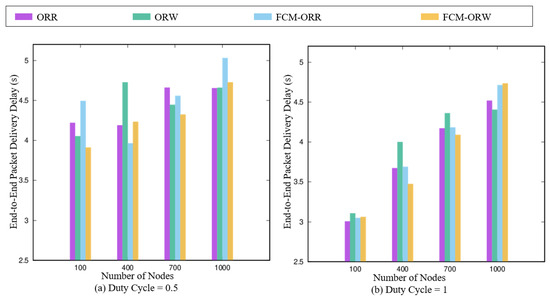
Figure 15.
Comparison of the end-to-end packet delivery delay with varying non-uniform densities and duty cycles (for a single packet transmission).
Channel congestion resulted in end-to-end packet delivery delays. Moreover, the delay of the proposed protocol was mostly greater than that of existing protocols. This results from the additional delay as the packet travels through low-density areas, which may not be the shortest path toward the sink node.
5.2.10. Changes in Packet Delivery Ratio vs. Duty Cycle
Figure 16 illustrates the packet delivery ratio across varying node densities under different duty cycle conditions. Since all the compared protocols employ opportunistic routing by transmitting packets through available relay nodes, the initial packets are successfully delivered to the sink. The primary distinction lies in the extent to which redundant packet transmissions are minimized. The graph indicates that in low-density networks, the proposed protocols exhibit suboptimal performance due to a higher ratio of redundant packet deliveries. However, in high-density scenarios, our protocols effectively mitigate redundant transmissions, thereby improving overall network efficiency.
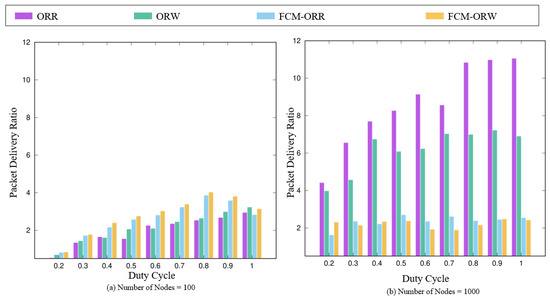
Figure 16.
Comparison of the packet delivery ratio with varying non-uniform densities and duty cycles.
5.2.11. Performance of Individual Protocols
According to the definition of the OR protocol, MAC and routing layers operate simultaneously. Hence, the packet filtering method for the MAC layer requires the routing layer information. The MAC layer packet-filtering performance of the implemented protocols is shown in Figure 17. The MAC layer packet classification of the four protocols, including the number of packets received and sent from the routing and radio layers and the number of ACK packets sent, is shown in Figure 17a–d.Based on the analysis, in a high-density network, the number of packets received from the radio layer of FCM-OR is less than those of ORW and ORR. This implies that fewer transmissions of redundant packets exist in the proposed protocol. This is because FCM clustering was used, which drove packets through a low-density area. However, the “sent data” or sender waiting time was reduced in FCM-OR, as this protocol limited the number of forwarders.
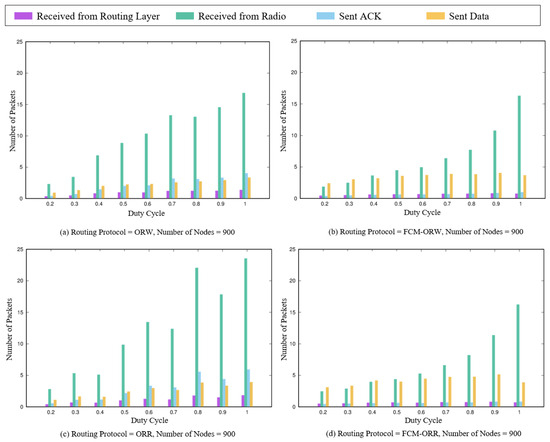
Figure 17.
MAC layer packet classification of different OR protocols with varying duty cycles in a highly dense area.
It is found in Figure 17 that the sender’s waiting time (as indicated by the “sent data” metric) rises in FCM-OR when comparing ORW with FCM-ORW and ORR with FCM-ORR. This suggests that even though there are eligible nodes in high-density areas, the sender may encounter longer delays in FCM-OR while waiting for a suitable forwarder from a low-density region. Although this design decision effectively reduces redundant transmissions, latency is introduced. Investigating a trade-off mechanism that strikes a balance between the advantages of low-density forwarding and the requirement for timely data delivery is, therefore, crucial.
5.3. Computational Complexity
The computational complexity of the proposed FCM-OR protocol is expressed as follows:
where N is the total number of nodes in the network, denotes the cost of the fuzzy c-means clustering step, and represents the cost of computing the Forwarding Rank (FR) for candidate forwarders.
The complexity of FCM clustering for a single node is as follows:
where is the number of one-hop neighbors, c is the number of clusters, and t is the number of iterations until convergence. As both c and t are constants in our implementation, this simplifies to the following:
Similarly, FR computation is performed over the same nodes:
Thus, the total worst-case complexity becomes the following:
In sparse regions where is below the clustering threshold and FCM is skipped, the complexity reduces to the following:
Therefore, the worst-case computational complexity of FCM-OR is , where is the number of neighbor nodes considered during local clustering and FR computation. In sparse regions where clustering is bypassed, the complexity reduces to , making the protocol scalable and lightweight for resource-constrained sensor nodes.
The overall protocol efficiency is evaluated using key performance metrics, including packet retransmission overhead (Figure 7, Figure 12 and Figure 16), collision rate per packet (Figure 10), and end-to-end packet delivery delay (Figure 15). Simulation results confirm that packet overhead and collision rates are significantly lower in FCM-OR than in ORW and ORR. However, end-to-end delay is slightly higher due to detour routing, which avoids high-density areas to improve energy efficiency and network longevity.
6. Analysis and Discussion
This study evaluates the proposed FCM-OR protocol against two well-established opportunistic routing (OR) protocols, ORW and ORR, as they serve as foundational protocols in asynchronous duty-cycled WSNs. ORW introduced asynchronous duty cycles to OR, optimizing energy efficiency, while ORR addressed load-balancing issues through improved routing metric calculations. However, existing methods suffer from redundant transmissions, inefficient forwarder selection, and link quality estimation overhead.
Our approach enhances these protocols by integrating clustering-based forwarder selection and an efficient link quality assessment method. Unlike ORW, which relies on energy-intensive probing for link estimation, FCM-OR employs received signal strength (RSSI) from the radio layer, reducing computational overhead. This method allows the routing metric to decrease with improved link quality, ensuring energy-efficient forwarder selection. Additionally, the clustering mechanism prioritizes nodes in less dense regions, minimizing redundant transmissions, collisions, and unnecessary energy consumption.
Simulation results confirm that FCM-OR outperforms ORW and ORR in terms of energy consumption, network lifetime, load balancing, and collision minimization. As demonstrated in Figure 7, Figure 12, and Figure 16, packet delivery ratio (PDR) values exceed one due to multiple packet receptions at the sink, highlighting the impact of redundant forwarding. Future research could extend this comparison to more recent OR protocols. Furthermore, adaptive parameter selection based on application-specific requirements can further optimize performance trade-offs in energy-constrained WSNs.
Moreover, in this study, we have derived a detailed calculation of computational complexity in Section 5.3, where it is proven that our protocol can explicitly reduce computational overhead, making the protocol scalable and lightweight for resource-constrained sensor nodes. On the other hand, several recent works such as [56,57,58,59] did not consider the computational overhead for the algorithm. Furthermore, compared to the total delay, computation overhead is ignorable.
7. Future Research Directions
While the proposed FCM-OR protocol demonstrates superior performance compared to existing approaches, certain limitations require further investigation:
- Longer sender waiting time: One limitation of FCM-OR is the longer sender waiting time when choosing forwarders from low-density areas. As explained in Section 5.2.9 and shown in the “Sent Data” metric in Figure 17, nodes in sparse regions usually wake up later in duty-cycled networks, which causes delays and increases the sender’s energy use. To overcome this, future work will focus on improving the forwarder selection process by finding a better balance between reducing redundant transmissions and keeping delays low. This could include combining both density and expected delay when picking forwarders or using predictive wake-up techniques to help the sender avoid waiting too long.
- Beacon-based link quality estimation: To further enhance energy efficiency, future work will incorporate beacon packet probing for link quality estimation, as implemented in ORW [3]. This will enable precise link quality assessment, facilitating more energy-aware forwarder selection and enabling a comprehensive evaluation of energy consumption trade-offs in asynchronous duty-cycled WSNs.
8. Conclusions
The combination of OR with asynchronous duty-cycle MAC has always posed a significant challenge in WSNs. Both have distinct implementation problems, and many studies have been conducted in this field. However, this study focused on non-uniformly distributed sensor deployment in which the node density is not even throughout the sensor field. We exploited this unevenness and used a clustering algorithm with a routing metric calculation to allow data packets to travel to less dense areas to reduce the number of receiver nodes and, in turn, reduce redundant transmissions. Based on simulation results, our protocol outperformed the existing ORW and ORR protocols. However, we observed some problems, which we aim to address in future studies.
Author Contributions
Detailed analysis and original draft preparation, A.A.L., M.K., and S.S; research supervision and provision of necessary feedback, M.K. and S.S. All authors have read and agreed to the published version of the manuscript.
Funding
This study was supported by a research fund from Chosun University (2019).
Data Availability Statement
The raw data supporting the conclusions of this article will be made available by the authors on request.
Conflicts of Interest
The authors declare no conflicts of interest.
References
- Biswas, S.; Morris, R. ExOR: Opportunistic MultiHop Routing for Wireless Networks. SIGCOMM Comput. Commun. Rev. 2005, 35, 133–144. [Google Scholar] [CrossRef]
- Ye, W.; Heidemann, J.; Estrin, D. Medium access control with coordinated adaptive sleeping for wireless sensor networks. IEEE/ACM Trans. Netw. 2004, 12, 493–506. [Google Scholar] [CrossRef]
- Ghadimi, E.; Landsiedel, O.; Soldati, P.; Duquennoy, S.; Johansson, M. Opportunistic Routing in Low Duty-Cycle Wireless Sensor Networks. ACM Trans. Sen. Netw. 2014, 10, 1–39. [Google Scholar] [CrossRef]
- Lata, A.A.; Kang, M. A Survey on the Evolution of Opportunistic Routing with Asynchronous Duty-Cycled MAC in Wireless Sensor Networks. Sensors 2020, 20, 4112. [Google Scholar] [CrossRef]
- Siraj, M. A Survey on Routing Algorithms and Routing Metrics for Wireless Mesh Networks. World Appl. Sci. J. 2014, 30, 870–886. [Google Scholar]
- Zaumen, W.T.; Garcia-Luna Aceves, J.J. Dynamics of Distributed Shortest-Path Routing Algorithms. SIGCOMM Comput. Commun. Rev. 1991, 21, 31–42. [Google Scholar] [CrossRef]
- So, J.; Byun, H. Load-Balanced Opportunistic Routing for Duty-Cycled Wireless Sensor Networks. IEEE Trans. Mob. Comput. 2017, 16, 1940–1955. [Google Scholar] [CrossRef]
- So, J.; Byun, H. Opportunistic routing with in-network aggregation for duty-cycled WSNs with delay requirements. EURASIP J. Wirel. Commun. Netw. 2014, 2014, 217. [Google Scholar] [CrossRef]
- Khan, A.; Javaid, N.; Sher, A.; Abbasi, R.A.; Ahmad, Z.; Ahmed, W. Load Balancing and Collision Avoidance Using Opportunistic Routing in Wireless Sensor Networks. In Proceedings of the 2018 IEEE 32nd International Conference on Advanced Information Networking and Applications (AINA), Krakow, Poland, 16–18 May 2018; pp. 236–243. [Google Scholar] [CrossRef]
- Bezdek, J.C.; Ehrlich, R.; Full, W. FCM: The fuzzy c-means clustering algorithm. Comput. Geosci. 1984, 10, 191–203. [Google Scholar] [CrossRef]
- Jain, A.; Goel, A.K. Energy Efficient Algorithm for Wireless Sensor Network using Fuzzy C-Means Clustering. Int. J. Adv. Comput. Sci. Appl. 2018, 9, 474–481. [Google Scholar] [CrossRef]
- Wang, P.; Wang, H. A Modified FCM Algorithm for MRI Brain Image Segmentation. In Proceedings of the 2008 International Seminar on Future BioMedical Information Engineering, Wuhan, China, 18 December 2008; pp. 26–29. [Google Scholar] [CrossRef]
- Sert, S.A.; Alchihabi, A.; Yazici, A. A Two-Tier Distributed Fuzzy Logic Based Protocol for Efficient Data Aggregation in Multihop Wireless Sensor Networks. IEEE Trans. Fuzzy Syst. 2018, 26, 3615–3629. [Google Scholar] [CrossRef]
- Sert, S.A.; Yazıcı, A. Optimizing the Performance of Rule-Based Fuzzy Routing Algorithms in Wireless Sensor Networks. In Proceedings of the 2019 IEEE International Conference on Fuzzy Systems (FUZZ-IEEE), New Orleans, LA, USA, 23–26 June 2019; pp. 1–6. [Google Scholar] [CrossRef]
- Sert, S.A.; Yazici, A. Increasing energy efficiency of rule-based fuzzy clustering algorithms using CLONALG-M for wireless sensor networks. Appl. Soft Comput. 2021, 109, 107510. [Google Scholar] [CrossRef]
- Farooq, M.O.; Dogar, A.B.; Shah, G.A. MR-LEACH: Multihop Routing with Low Energy Adaptive Clustering Hierarchy. In Proceedings of the 2010 Fourth International Conference on Sensor Technologies and Applications, Venice, Italy, 18–25 July 2010; pp. 262–268. [Google Scholar] [CrossRef]
- Zhong, Z.; Wang, J.; Nelakuditi, S.; Lu, G.H. On Selection of Candidates for Opportunistic Anypath Forwarding. SIGMOBILE Mob. Comput. Commun. Rev. 2006, 10, 1–2. [Google Scholar] [CrossRef]
- Chachulski, S.; Jennings, M.; Katti, S.; Katabi, D. Trading Structure for Randomness in Wireless Opportunistic Routing. SIGCOMM Comput. Commun. Rev. 2007, 37, 169–180. [Google Scholar] [CrossRef]
- Zeng, K.; Lou, W.; Yang, J.; Brown, D.R. On Throughput Efficiency of Geographic Opportunistic Routing in Multihop Wireless Networks. In Proceedings of the Fourth International Conference on Heterogeneous Networking for Quality, Reliability, Security and Robustness Workshops, Vancouver, BC, Canada, 14–17 August 2007. [Google Scholar] [CrossRef]
- Rozner, E.; Seshadri, J.; Mehta, Y.; Qiu, L. SOAR: Simple Opportunistic Adaptive Routing Protocol for Wireless Mesh Networks. IEEE Trans. Mob. Comput. 2009, 8, 1622–1635. [Google Scholar] [CrossRef]
- Hung, C.C.; Lin, K.; Chou, C.F.; Hsu, C.C. EFFORT: Energy-efficient opportunistic routing technology in wireless sensor networks. Wirel. Commun. Mob. Comput. 2013, 13, 760–773. [Google Scholar] [CrossRef]
- Zhang, X.; Li, B. Optimized multipath network coding in lossy wireless networks. IEEE J. Sel. Areas Commun. 2009, 27, 622–634. [Google Scholar] [CrossRef]
- Hawbani, A.; Wang, X.; Sharabi, Y.; Ghannami, A.; Kuhlani, H.; Karmoshi, S. LORA: Load-Balanced Opportunistic Routing for Asynchronous Duty-Cycled WSN. IEEE Trans. Mob. Comput. 2019, 18, 1601–1615. [Google Scholar] [CrossRef]
- Abedi, O.; Razaghi Kariznoi, S. Load-balanced and energy-aware opportunistic routing with adaptive duty cycling for multi-channel WSNs. J. Supercomput. 2021, 77, 1038–1058. [Google Scholar] [CrossRef]
- Liu, F.; Zhang, Z.; Liu, Y. Low-Delay Opportunistic Routing with Reducing Overhead in Asynchronous Duty-Cycled Wireless Sensor Networks. Wirel. Commun. Mob. Comput. 2022, 2022, 2308615. [Google Scholar] [CrossRef]
- Qaisar, M.U.F.; Wang, X.; Hawbani, A.; Khan, A.; Ahmed, A.; Wedaj, F.T.; Ullah, S. TORAS: Trustworthy Load-Balanced Opportunistic Routing for Asynchronous Duty-Cycled WSNs. IEEE Syst. J. 2022, 17, 2259–2270. [Google Scholar] [CrossRef]
- Jain, S.; Das, S. Exploiting path diversity in the link layer in wireless ad hoc networks. In Proceedings of the 6th IEEE International Symposium on a World of Wireless Mobile and Multimedia Networks, Taormina-Giardini Naxos, Italy, 16 June 2005; pp. 22–30. [Google Scholar] [CrossRef]
- Westphal, C. Opportunistic Routing in Dynamic Ad Hoc Networks: The OPRAH protocol. In Proceedings of the 2006 IEEE International Conference on Mobile Ad Hoc and Sensor Systems, Vancouver, BC, Canada, 9–12 October 2006; Volume 1, pp. 570–573. [Google Scholar] [CrossRef]
- Yuan, Y.; Yang, H.; Wong, S.H.Y.; Lu, S.; Arbaugh, W. ROMER: Resilient opportunistic mesh routing for wireless mesh networks. In Proceedings of the 1st IEEE Workshop on Wireless Mesh Networks (WiMesh), Santa Clara, CA, USA, 26 September 2005. [Google Scholar]
- Nassr, M.S.; Jun, J.; Eidenbenz, S.J.; Hansson, A.A.; Mielke, A.M. Scalable and Reliable Sensor Network Routing: Performance Study from Field Deployment. In Proceedings of the IEEE INFOCOM 2007—26th IEEE International Conference on Computer Communications, Anchorage, AK, USA, 6–12 May 2007; pp. 670–678. [Google Scholar] [CrossRef]
- Wang, Z.; Chen, Y.; Li, C. CORMAN: A Novel Cooperative Opportunistic Routing Scheme in Mobile Ad Hoc Networks. IEEE J. Sel. Areas Commun. 2012, 30, 289–296. [Google Scholar] [CrossRef]
- Holger, F.; Widmer, J.; Michael, K.; Mauve, M.; Hartenstein, H. Contention-based forwarding for mobile ad hoc networks. Ad Hoc Netw. 2003, 1, 351–369. [Google Scholar] [CrossRef]
- Zorzi, M.; Rao, R. Geographic random forwarding (GeRaF) for ad hoc and sensor networks: Multihop performance. IEEE Trans. Mob. Comput. 2003, 2, 337–348. [Google Scholar] [CrossRef]
- Zhao, B.; Seshadri, R.; Valenti, M. Geographic random forwarding with hybrid-ARQ for ad hoc networks with rapid sleep cycles. In Proceedings of the IEEE Global Telecommunications Conference, 2004. GLOBECOM ’04, Dallas, TX, USA, 29 November–3 December 2004; Volume 5, pp. 3047–3052. [Google Scholar] [CrossRef]
- Zeng, K.; Lou, W.; Zhai, H. Capacity of opportunistic routing in multi-rate and multihop wireless networks. IEEE Trans. Wirel. Commun. 2008, 7, 5118–5128. [Google Scholar] [CrossRef]
- Yang, S.; Zhong, F.; Yeo, C.K.; Lee, B.S.; Boleng, J. Position Based Opportunistic Routing for Robust Data Delivery in MANETs. In Proceedings of the GLOBECOM 2009—2009 IEEE Global Telecommunications Conference, Honolulu, HI, USA, 30 November–4 December 2009; pp. 1–6. [Google Scholar] [CrossRef]
- Couto, D.S.J.D.; Aguayo, D.; Bicket, J.; Morris, R. A high-throughput path metric for multihop wireless routing. Wirel. Netw. 2005, 11, 419–434. [Google Scholar] [CrossRef]
- Hsu, C.J.; Liu, H.I.; Seah, W. Economy: A Duplicate Free Opportunistic Routing. In Proceedings of the 6th International Conference on Mobile Technology, Application and Systems, Nice, France, 2–4 September 2009. [Google Scholar] [CrossRef]
- Draves, R.; Padhye, J.; Zill, B. Routing in Multi-Radio, MultiHop Wireless Mesh Networks. In Proceedings of the 10th Annual International Conference on Mobile Computing and Networking, Philadelphia, PA, USA, 26 September–1 October 2004; pp. 114–128. [Google Scholar] [CrossRef]
- Zubow, A.; Kurth, M.; Redlich, J.P. Opportunistic Protocols in Multi-rate Environments. In Proceedings of the 2008 Second International Conference on Sensor Technologies and Applications (Sensorcomm 2008), Cap Esterel, France, 25–31 August 2008; pp. 743–751. [Google Scholar] [CrossRef]
- Lee, J.Y.; Yu, C.; Shin, K.G.; Suh, Y.J. Maximizing Transmission Opportunities in Wireless Multihop Networks. IEEE Trans. Mob. Comput. 2013, 12, 1879–1892. [Google Scholar] [CrossRef]
- Yan, Y.; Zhang, B.; Mouftah, H.T.; Ma, J. Practical Coding-Aware Mechanism for Opportunistic Routing in Wireless Mesh Networks. In Proceedings of the 2008 IEEE International Conference on Communications, Beijing, China, 19–23 May 2008; pp. 2871–2876. [Google Scholar] [CrossRef]
- Zhong, Z.; Nelakuditi, S. On the Efficacy of Opportunistic Routing. In Proceedings of the 2007 4th Annual IEEE Communications Society Conference on Sensor, Mesh and Ad Hoc Communications and Networks, San Diego, CA, USA, 18–21 June 2007; pp. 441–450. [Google Scholar] [CrossRef]
- Dubois-Ferrière, H.; Grossglauser, M.; Vetterli, M. Valuable Detours: Least-Cost Anypath Routing. IEEE/ACM Trans. Netw. 2011, 19, 333–346. [Google Scholar] [CrossRef]
- Laufer, R.; Velloso, P.B.; Vieira, L.; Kleinrock, L. PLASMA: A new routing paradigm for wireless multihop networks. In Proceedings of the 2012 Proceedings IEEE INFOCOM, Orlando, FL, USA, 25–30 March 2012; pp. 2706–2710. [Google Scholar]
- Laufer, R.; Dubois-Ferriere, H.; Kleinrock, L. Multirate Anypath Routing in Wireless Mesh Networks. In Proceedings of the IEEE INFOCOM 2009, Rio de Janeiro, Brazil, 19–25 April 2009; pp. 37–45. [Google Scholar] [CrossRef]
- Zhao, Z.; Rosario, D.; Braun, T.; Cerqueira, E. Context-aware opportunistic routing in mobile ad-hoc networks incorporating node mobility. In Proceedings of the 2014 IEEE Wireless Communications and Networking Conference (WCNC), Istanbul, Turkey, 6–9 April 2014; pp. 2138–2143. [Google Scholar] [CrossRef]
- Wei, C.; Zhi, C.; Fan, P.; Letaief, K.B. AsOR: An energy efficient multihop opportunistic routing protocol for wireless sensor networks over Rayleigh fading channels. IEEE Trans. Wirel. Commun. 2009, 8, 2452–2463. [Google Scholar] [CrossRef]
- Mao, X.; Tang, S.; Xu, X.; Li, X.Y.; Ma, H. Energy-Efficient Opportunistic Routing in Wireless Sensor Networks. IEEE Trans. Parallel Distrib. Syst. 2011, 22, 1934–1942. [Google Scholar] [CrossRef]
- Zuo, J.; Dong, C.; Nguyen, H.V.; Ng, S.X.; Yang, L.L.; Hanzo, L. Cross-Layer Aided Energy-Efficient Opportunistic Routing in Ad Hoc Networks. IEEE Trans. Commun. 2014, 62, 522–535. [Google Scholar] [CrossRef]
- Zhang, P.; Landsiedel, O.; Theel, O. MOR: Multichannel Opportunistic Routing for Wireless Sensor Networks. In Proceedings of the 2017 International Conference on Embedded Wireless Systems and Networks, Uppsala, Sweden, 20–22 February 2017; pp. 36–47. [Google Scholar]
- Wang, X.; Zhou, W.; Hawbani, A.; Liu, P.; Zhao, L.; Alsamhi, S.H. A Dynamic Opportunistic Routing Protocol for Asynchronous Duty-Cycled WSNs. IEEE Trans. Sustain. Comput. 2023, 8, 314–327. [Google Scholar] [CrossRef]
- Moss, D.; Levis, P. BoX-MACs: Exploiting Physical and Link Layer Boundaries in Low-Power Networking. 2008. Available online: https://www.google.co.uk/url?sa=t&source=web&rct=j&opi=89978449&url=https://citeseerx.ist.psu.edu/document%3Frepid%3Drep1%26type%3Dpdf%26doi%3D1fb9c66c22019c58bd512b9e6eb5f4ab1f223aa4&ved=2ahUKEwiy9LfYhvyMAxVR1zQHHd7KBTMQFnoECBYQAQ&usg=AOvVaw3YKbAlfTeY-PMuy565RoSp (accessed on 15 October 2020).
- Hoang, D.; Kumar, R.; Panda, S. Fuzzy C-Means clustering protocol for Wireless Sensor Networks. In Proceedings of the 2010 IEEE International Symposium on Industrial Electronics, Bari, Italy, 4–7 July 2010; pp. 3477–3482. [Google Scholar] [CrossRef]
- Heinzelman, W.; Chandrakasan, A.; Balakrishnan, H. An application-specific protocol architecture for wireless microsensor networks. IEEE Trans. Wirel. Commun. 2002, 1, 660–670. [Google Scholar] [CrossRef]
- Rahman, Z.; Hashim, F.; Rasid, M.F.A.; Othman, M. Totally opportunistic routing algorithm (TORA) for underwater wireless sensor network. PLoS ONE 2018, 13, e0197087. [Google Scholar] [CrossRef] [PubMed]
- Al-kahtani, M.S.; Karim, L.; Khan, N. ODCR: Energy Efficient and Reliable Density Clustered-based Routing Protocol for Emergency Sensor Applications. Appl. Comput. Inform. 2020; ahead-of-print. [Google Scholar] [CrossRef]
- Bangotra, D.K.; Singh, Y.; Selwal, A.; Kumar, N.; Singh, P.K. A Trust Based Secure Intelligent Opportunistic Routing Protocol for Wireless Sensor Networks. Wirel. Pers. Commun. 2022, 127, 1045–1066. [Google Scholar] [CrossRef]
- Yang, R.; Patil, M.A.; Narayana, P.; Jayaram, D.; Keerthi, K.; SudhakarYadav, N.; Chithaluru, P.; Kumar, S.; Elminaam, D.S.A.; Alsekait, D.M. EDSSR: A Secure and Power-Aware Opportunistic Routing Scheme for WSNs. Sci. Rep. 2024, 14, 28625. [Google Scholar] [CrossRef]
Disclaimer/Publisher’s Note: The statements, opinions and data contained in all publications are solely those of the individual author(s) and contributor(s) and not of MDPI and/or the editor(s). MDPI and/or the editor(s) disclaim responsibility for any injury to people or property resulting from any ideas, methods, instructions or products referred to in the content. |
© 2025 by the authors. Licensee MDPI, Basel, Switzerland. This article is an open access article distributed under the terms and conditions of the Creative Commons Attribution (CC BY) license (https://creativecommons.org/licenses/by/4.0/).